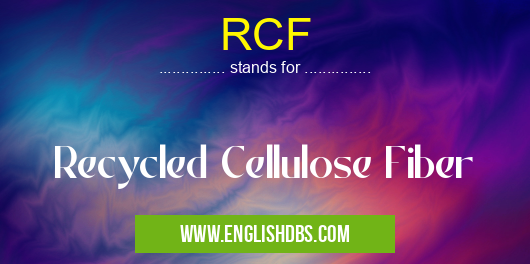What does RCF mean in UNCLASSIFIED
RCF stands for Recycled Cellulose Fiber. It is a type of fiber that is made from recycled paper or cardboard. RCF is used in a variety of products, including paper, cardboard, and insulation.

RCF meaning in Unclassified in Miscellaneous
RCF mostly used in an acronym Unclassified in Category Miscellaneous that means Recycled Cellulose Fiber
Shorthand: RCF,
Full Form: Recycled Cellulose Fiber
For more information of "Recycled Cellulose Fiber", see the section below.
Types of RCF
There are two main types of RCF:
- Pre-consumer RCF: This type of RCF is made from paper or cardboard that has been recycled before it has been used by consumers.
- Post-consumer RCF: This type of RCF is made from paper or cardboard that has been used by consumers and then recycled.
Benefits of RCF
Using RCF has a number of benefits, including:
- Reduced environmental impact: RCF helps to reduce the amount of paper and cardboard that is sent to landfills.
- Conserves resources: RCF helps to conserve natural resources, such as trees and water.
- Reduces greenhouse gas emissions: RCF helps to reduce greenhouse gas emissions by reducing the need for new paper and cardboard production.
Essential Questions and Answers on Recycled Cellulose Fiber in "MISCELLANEOUS»UNFILED"
What is Recycled Cellulose Fiber (RCF)?
RCF is a type of fiber made from recycled paper and cardboard. It is a sustainable and environmentally friendly alternative to virgin fibers, as it reduces the need for logging and deforestation.
How is RCF produced?
RCF is produced by a process called deinking, which involves removing inks, coatings, and adhesives from recycled paper and cardboard. The resulting pulp is then bleached and processed into fibers.
What are the benefits of using RCF?
Using RCF has several benefits, including:
- Sustainability: RCF reduces the need for virgin fibers, conserving forests and reducing deforestation.
- Environmental friendliness: RCF production requires less energy and water than virgin fiber production, and it reduces greenhouse gas emissions.
- Cost-effectiveness: RCF is often more cost-effective than virgin fibers, as it does not require the same level of processing.
What are the applications of RCF?
RCF is used in a wide range of applications, including:
- Papermaking: RCF is used to make new paper and cardboard products, such as printing paper, packaging materials, and tissue paper.
- Nonwovens: RCF is used to make nonwoven fabrics, which are used in products such as wipes, diapers, and medical dressings.
- Insulation: RCF is used to make insulation materials, which help to reduce energy consumption in buildings.
Is RCF safe to use?
Yes, RCF is safe to use. It is non-toxic and does not contain any harmful chemicals. It has been approved by regulatory agencies around the world for use in food packaging, medical products, and other applications.
Final Words: RCF is a sustainable and environmentally friendly material that can be used in a variety of products. Using RCF helps to reduce the amount of waste that is sent to landfills, conserve natural resources, and reduce greenhouse gas emissions.
RCF also stands for: |
|
| All stands for RCF |
